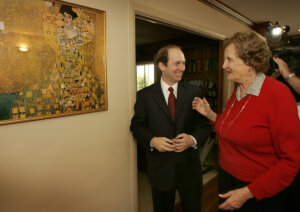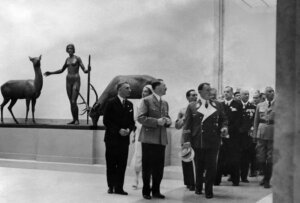Uncategorized
As long as there are movies about Nazis, there will be movies about the art they looted

Early on in Pascal Bonitzer’s film Auction, Andre (Alex Lutz). a self-serving and sleazy art dealer, is placating a condescending, cruel, and racist art owner. “You have to stop at nothing for a sale,” he tells his intern.
The French film vividly brings to life the deceptive and hypocritical high-stakes world of prestigious art dealers operating in a Parisian universe of money grubbing and bad faith.

Based on a true story, it recounts what transpired in 2005, when a major work by Expressionist artist Egon Schiele, “Wilted Sunflowers,” was discovered in a home in a suburb of Mulhouse, France.
The 1914 painting originally belonged to the Jewish Austrian collector Karl Grunwald and had last been seen in public at the Jeu de Paume in Paris in 1937. In 1938 Grunwald fled Vienna for Paris, saving as many paintings as he could in a storage unit. They were ultimately looted and auctioned off.
Grunwald made it to America, while his wife and children were killed in concentration camps. For the rest of his life he futilely tried to recover his stolen paintings. Following his death in 1964, one of his sons persevered in his late father’s pursuit.
Bonitzer places the Schiele in the home of Martin (Arcadi Radeff) a highly moral, arguably sentimentalized, young factory worker who has no idea of its monetary value or backstory. Concepts of “provenance” are alien to him; he could use some money and just wants to do the right thing. So do the rightful heirs.
The whole story ends on a positive note as the painting gets sold at auction and the young worker is given an equal share in the sale.

It is estimated that more than 600,000 paintings, decorative items and other aesthetically and culturally valued items were summarily stolen from Jews during the War. Approximately, 100,000 have never been recovered.
Auction is only the latest in a long line of works centering on Nazi-looted art.
Perhaps the best known film in this sub-genre is 2015’s The Woman in Gold, which starred Helen Mirren as the patrician Maria Altmann, who works in tandem with her dogged attorney to retrieve six paintings by Gustav Klimt, one of which was a portrait of Maria’s aunt, Adele Bloch-Bauer I.
The Klimts were ripped off by the Nazis during World War II and exhibited in Austria at the Österreichische Galerie Belvedere until 2006. After a lengthy and byzantine legal battle, a number of the works were returned to the Altmann Family, which sold the Adele portrait for $135 million to Ronald Lauder who proudly displays the work in his Neue Galerie.
It would seem axiomatic that any stolen art should be restored to its original owners or, more usually, their heirs. For some, however, it’s a grayer area filled with moral and legal questions, starting with how the work was obtained. Was it purchased in good faith? If the current owners(let’s add “s”) truly didn’t know its origins should they be allowed to keep it? If not, how much compensation, if any, should they receive?
And, more broadly, who should own great art — a private collector or a museum? Doesn’t the public have a right to see great art? Wouldn’t it be better for a museum to have and display the work rather than a family who may hide it in its basement?

One of the most interesting elements in the “Gold” story, which was also addressed in the documentaries Adele’s Wishes and Stealing Klimt was the Austrian government’s contention that Adele, who succumbed to meningitis in 1925, had in fact left the painting to her husband with the stipulation that when he died it would go to the Austrian gallery. Therefore it was rightly theirs.
But if the will existed — and that was debatable — was it legally binding since Adele’s husband was forced to flee the country in the wake of Germany’s annexation of Austria, which Adele had no way of anticipating? Her will, if there was one, was predicated on the idea that he would die at home and that his art collection would remain intact and in his possession when he passed.
The Rape of Europa, a comprehensive and detailed documentary on pillaged art also touches on the dilemma surrounding Adele’s portrait, but it places the crime in a wider context, considering the questions that emerge when one country or culture appropriates the art of another. Still, it makes clear that the most egregious example is the Nazi seizure of Jewish art.
Much of the art in question, modern, abstract and acclaimed by the likes of Picasso, Kandinsky, Klee, much of it owned by Jewish collectors, fell into the category that Hitler dubbed “degenerate,” which gave him the opportunity to further dehumanize those owners. Most of the paintings were destroyed while others were sold for enormous profits in order to underwrite a massive build up of armaments for the Third Reich.
The documentary, The Portrait of Wally, is a searing indictment of MoMA and other major American art institutions that supported MoMA in a less-than-exemplary 1997 episode.
The film recounts the brouhaha surrounding Egon Schiele’s painting of his mistress Wally, owned by Lea Bondi, a Jewish Austrian art dealer before it was grabbed by the Nazis in 1939.

Prior to landing at MoMA it was housed in Rudolph Leopold’s Austrian museum. Leopold was a classic double dealer, pretending to be on the side of the original owners and their heirs when in fact he had no intention of handing over the painting.
But when the painting was on loan to MoMA, the Bondi heirs demanded that it be returned to them. Rudolph refused, which led to a 13-year criminal investigation launched by New York District Attorney Robert Morgenthau, during which time the painting was held by the United States government.
According to the film, MoMA and other art institutions sided with Rudolph because they were afraid that aligning themselves with the Jewish family would mean that museums across the globe would no longer lend their works to American museums for fear that they might potentially lose their art or have to pay big bucks to have it returned.
Ultimately in 2010 the Bondi heirs prevailed. The Leopold Museum paid them $19 million for the painting’s return. That case succeeded in opening the floodgates to many others. And a surge of films on the topic followed.

Movies centering on Nazi-looted art have been around for decades, such as John Frankenheimer’s 1965 action thriller The Train starring Burt Lancaster; and 39 years later George Clooney’s The Monuments Men, both loosely inspired by factual events.
Set in 1944, shortly before the end of the war, The Train is a suspenseful and well-acted account of a French resistance fighter (Lancaster) determined to intercept a train carrying Nazi looted art from France to Germany without destroying the art.
Set in the same era, the starry Monuments Men, co-written and directed by George Clooney and featuring Clooney, Matt Damon, Bill Murray, and Cate Blanchett, among others, depicts a unit of historians and archivists on a mission to locate and salvage works of art across Europe before the Nazis had a chance to steal and destroy them.”
Despite the caliber of talent involved, e.g., the film was seen as problematic because of its failure to point out that many, if not most, of these art works had belonged to Jews and were brutally confiscated from the original owners, many of whom had been carted off to concentration camps to be killed.
Clooney and his Jewish co-writer said that their purpose was to explore not the experience of any one group but the profound significance of great art and the violation that’s perpetrated when it is stolen, or worse, destroyed.
Both Clooney and Frankenheimer’s films also touch on the moral quandary of whether a great painting is more valuable than a human life. If the risk to save the art is that high is it worth taking?

For me the most affecting film on lost art is Elizabeth Rynecki’s 2018 documentary Chasing Portraits, her freshman endeavor. Even though — perhaps precisely because — at times it feels more like a home movie than a professionally honed flick it reveals an emotional core that is unexpectedly moving.
Equally relevant, her film centers on paintings that were scattered after the War. They may or may not have been looted, but their fate was directly tied to the Nazi regime that forced Jewish residents to escape without their precious belongings.
Rynecki grew up surrounded by the art of her great-grandfather Moshe Rynecki, who was murdered at Majdanek in 1943. His evocative expressionistic works portray the day to day life of Polish Jews prior to the Holocaust. Of his estimated 800 works, 120 remain in Polish and Israeli museums and private collections abroad.
Throughout her life Rynecki had wanted to see these works, not to reclaim them, but to uncover how they ended up where they were. She serves as a historian and witness, her great grandfather’s art a link to her family and Jewish heritage and a world that is gone forever.
The film follows her as she travels from Canada to Poland and Israel where she is, by turns, regarded with suspicion or more usually snubbed outright. Many owners, some Jewish, cannot believe that she is not there for restitution. In one of the strongest scenes, a Polish collector, a gentile, wraps up and hands over to Elizabeth one of her great grandfather’s paintings, unsolicited.
It’s a story that lingers and will no doubt continue to inspire more documentaries and feature films. Just this week, The Guardian reported that the heirs of a Jewish couple are suing The Metropolitan Museum of Art in New York over a Vincent van Gogh painting they say was plundered by the Nazis.
‘Auction’ is currently screening in New York at Film Forum.
The post As long as there are movies about Nazis, there will be movies about the art they looted appeared first on The Forward.
Uncategorized
The call of this Hanukkah moment remains simple and urgent: Light candles everywhere. Even when we’re under attack.
The massacre in Sydney has left Jews around the world shaken and grieving. This act is far more than a heinous crime: It is a regression to darker times, when Jewish visibility itself carried mortal risk.
The commandment of Hanukkah is not simply to light candles, but to light them publicly – pirsumei nisa, the publicizing of the miracle. The point is not private consolation, but shared visibility. Jewish survival, the tradition teaches, is not meant to occur behind closed doors, but in full view.
Historically, however, it rarely did. In exile, Jews learned caution. The Talmud records how, in times of danger, the candles are to be moved indoors – lit discreetly, shielded from hostile eyes. This was not a theological revision but a concession to reality: When the public sphere is unsafe, Jewish life retreats into the private domain. For most of our history, this was our reality.
Modern democracies promised something different. Jews would no longer have to choose between safety and visibility. We could light openly again – on windowsills, in public squares, in front of city halls – because the surrounding society would protect us not merely by law, but by norm. Antisemitism would not just be illegal, it would be unthinkable.
The Sydney massacre, alongside countless incidents in societies Jews have long trusted, forces us to ask whether that promise is still being kept.
Jewish safety in the diaspora does not rest primarily on police presence or intelligence services – necessary though they are. It rests on something more fragile and more fundamental: a public culture in which Jews are not merely tolerated but embraced; in which antisemitism is not merely condemned after the fact but rejected instinctively and unequivocally as a violation of the moral order.
When Jews are attacked for being Jews, and the response is muted, conditional, or delayed, the message is unmistakable. Jews may still live here, but only quietly.
That is why the response to Sydney must not be withdrawal, but the exact opposite. We cannot and will not retreat into hiding our light. The call of this moment is simple and urgent: Light candles everywhere.
Jewish communities and organizations must orchestrate public Hanukkah candle lightings in the central squares of democratic cities across Europe, across the English-speaking world, wherever Jews live under the protection of free societies. Not hidden ceremonies. Not fenced-off gatherings on the margins. But civic events, hosted openly and proudly, with the participation of local and national leaders – and of fellow non-Jewish citizens.
This is not unprecedented. Every year, a Hanukkah menorah is lit at the White House. The symbolism is powerful precisely because it is mundane: Jewish light belongs at the heart of the civic space, not as an exception, not as an act of charity, but as a matter of course. That model should now be replicated widely.
Israeli diplomatic missions, together with local Jewish organizations, should work actively with municipalities and governments to make these public lightings happen – not merely as acts of Jewish resilience, but as declarations of democratic commitment. Because this is not only a Jewish question.
A society in which Jews feel compelled to hide their symbols is a society already retreating from its own values. Antisemitism is never a stand-alone phenomenon; it is the canary in the democratic coal mine. Where Jews are unsafe, pluralism is already fraying.
Lighting candles in public squares will not undo the horror of Sydney. But it will answer it – not with fear, and not with silence, but with a refusal to normalize xenophobia, antisemitism, and Jewish invisibility.
The ancient question of Hanukkah – where we light – has returned as a modern moral test of democratic societies and leaders worldwide. Where Jewish light is extinguished, democracy itself is cast into shadow. If it can still be lit openly, with the full backing of the societies Jews call home, then the promise of democratic life remains alive.
Our light must not hide. Not now. Never again.
The post The call of this Hanukkah moment remains simple and urgent: Light candles everywhere. Even when we’re under attack. appeared first on The Forward.
Uncategorized
Australia shooting terrifies Jews worldwide — and strengthens the case for Israel
If the shooters who targeted Jews on a beach in Australia while they were celebrating Hanukkah thought their cowardly act would turn the world against Israel, they were exactly wrong: Randomly killing people at a holiday festival in Sydney makes the case for Israel.
The world wants Jews to disown Israel over Gaza, but bad actors keep proving why Jews worldwide feel such an intense need to have a Jewish state.
Think about it. The vast majority of Jews who settled in Israel went there because they felt they had nowhere else to go. To call the modern state “the ingathering of exiles” softpedals reality and tells only half the story. The ingathering was a result of an outpouring of hate and violence.
Attacking Jews is the best way to rationalize Zionism.
Judaism’s holidays are often (humorously) summarized as, “They tried to kill us, they failed, let’s eat.” Zionism is simply, “They tried to kill us, they failed, let’s move.”
Theodor Herzl, the founder of modern Zionism, didn’t have a religious or even a tribal bone in his body. He would have been happy to stay in Vienna writing light plays and eating sacher torte. But bearing witness to the rise of antisemitism, he saw the Land of Israel as the European Jew’s best option.
The Eastern European pogroms, the Holocaust, the massacre of Jews in Iraq in 1941 — seven years before the State of Israel was founded — the attacks on Jews throughout the Middle East after Israel’s founding, the oppression of Jews in the former Soviet Union — these were what sent Jews to Israel.
How many Australians are thinking the same way this dark morning?
There’s a lot to worry about in Israel. It is, statistically, more dangerous to be Jewish there than anywhere else in the world. But most Jews would rather take their chances on a state created to protect them, instead of one that just keeps promising it will – especially when the government turns a blind eye to antisemitic incitement and refuses to crack down on violent protests, as Australia has.
“For over a year we have seen racist mobs impeding on the rights and freedoms of ordinary Australians. We have been locked out of parts of our cities because the police could not ensure our safety. Students have been told to stay away from campuses. We have been locked down in synagogues,” Alex Ryvchin, the co-CEO of the Executive Council of Australian Jewry, wrote a year ago, after the firebombing attack on a Melbourne synagogue.
Since then a childcare centre in Sydney’s east was set alight by vandals, cars were firebombed, two Australian nurses threatened to kill Jewish patients, to name a few antisemitic incidents. There were 1,654 antisemitic incidents logged in Australia from October 2024 to September 2025 — in a country with about 117,000 Jews.
“The most dangerous thing about terrorism is the over-reaction to it,” the philosopher Yuval Noah Harari said. He was talking about the invasion of Iraq after 9/11, the crackdown on civil liberties and legitimate protest. But surely it’s equally dangerous to underreact to terrorism and terrorist rhetoric.
Israel’s destruction of Gaza following the Hamas attack of Oct. 7, 2023 led to worldwide protests, which is understandable, if not central to why tensions have escalated.
But condemning civilian casualties and calling for Palestinian self-determination — something many Jews support — too often crosses into calls for destroying Israel, demonizing Israelis and their Jews. That’s how Jews heard the phrase “globalize the intifada” — as a justification for the indiscriminate violence against civilians.
When they took issue with protesters cosplaying as Hamas and justifying the Oct. 7 massacre, that’s what they meant. And look at what happened in Bondi Beach, they weren’t wrong. Violence leads to violence, and so does support for violence.
Chabad, which hosted the Hanukkah celebration in Sydney, has always leaned toward a more open door policy with less apparent security than other Jewish institutions. But one of the reasons it has been so effective at outreach has also made it an easy target.
As a result of the Bondi shooting, Chabad will likely increase security, as will synagogues around the world. Jewish institutions will think hard about publicly advertising their events. Law enforcement and public officials will, thankfully, step up protection, at least for a while. These are all the predictable result of an attack that, given the unchecked antisemitic rhetoric and weak responses to previous antisemitic incidents, was all but inevitable.
It’s not inevitable that Australian Jews would now move to Israel, no more than it would have been for Pittsburgh’s Jewish community to uproot itself and move to Tel Aviv after the 2018 Tree of Life massacre. That didn’t happen, because ultimately the risk still doesn’t justify it.
But these shootings, and the constant drip of violent rhetoric, vandalism and confrontation raise a question: If you want to kill Jews in Israel, and you kill them outside Israel, where, exactly, are we supposed to go?
The post Australia shooting terrifies Jews worldwide — and strengthens the case for Israel appeared first on The Forward.
Uncategorized
These are the victims of the Bondi Beach Hanukkah celebration shooting in Sydney
(JTA) — A local rabbi, a Holocaust survivor and a 12-year-old girl are among those killed during the shooting attack Sunday on a Hanukkah celebration in Sydney, Australia.
Here’s what we know about the 11 people murdered in the attack, which took place at a popular beachside playground where more than 1,000 people had congregated to celebrate the first night of the holiday, as well as about those injured.
This story will be updated.
Eli Schlanger, rabbi and father of five
Schlanger was the Chabad emissary in charge of Chabad of Bondi, which had organized the event. He had grown up in England but moved to Sydney 18 years ago, where he was raising his five children with his wife Chaya. Their youngest was born just two months ago.
In addition to leading community events through Chabad of Bondi, Schlanger worked with Jewish prisoners in Australian prisons. “He flew all around the state, to go visit different people in jail, literally at his own expense,” Mendy Litzman, a Sydney Jew who responded as a medic to the attack, told the Jewish Telegraphic Agency.
Last year, amid a surge in antisemitic incidents in Australia, Schlanger posted a video of himself dancing and celebrating Hanukkah, promoting lighting menorahs as “the best response to antisemitism.”
The best response to antisemitism. Happy Chanukah! pic.twitter.com/33RSGYzhUY
— Rabbi Eli Schlanger (@SchlangerEli) December 17, 2024
Two months before his murder, he published an open letter to Australian Prime Minister Anthony Albanese urging him to rescind his “act of betrayal” of the Jewish people. The letter was published on Facebook the same day, Sept. 21, that Albanese announced he would unilaterally recognize an independent Palestinian state.
Alex Kleytman, Holocaust survivor originally from Ukraine
Kleytman had come to the Bondi Beach Hanukkah celebration annually for years, his wife Larisa told The Australian. She said he was protecting her when he was shot. The couple, married for six decades, has two children and 11 grandchildren.
The Australia reported that Kleytman was a Holocaust survivor who had passed World War II living with his family in Siberia.
12-year-old girl
Alex Ryvchin, co-CEO of the Executive Council of Australian Jewry, told CNN that a friend “lost his 12-year-old daughter, who succumbed to her wounds in hospital.” The girl’s name was not immediately released.
Dozens of people were injured
- Yossi Lazaroff, the Chabad rabbi at Texas A&M University, said his son had been shot while running the event for Chabad of Bondi. “Please say Psalms 20 & 21 for my son, Rabbi Leibel Lazaroff, יהודה לייב בן מאניא who was shot in a terrorist attack at a Chanukah event he was running for Chabad of Bondi in Sydney, Australia,” he tweeted.
- Yaakov “Yanky” Super, 24, was on duty for Hatzalah at the event when he was shot in the back, Litzman said. “He started screaming on his radio that he needs back up, he was shot. I heard it and I responded to the scene. I was the closest backup. I was one of the first medical people on the scene,” Litzman said. He added, “We just went into action and saved a lot of lives, including one of our own.”
The post These are the victims of the Bondi Beach Hanukkah celebration shooting in Sydney appeared first on The Forward.


